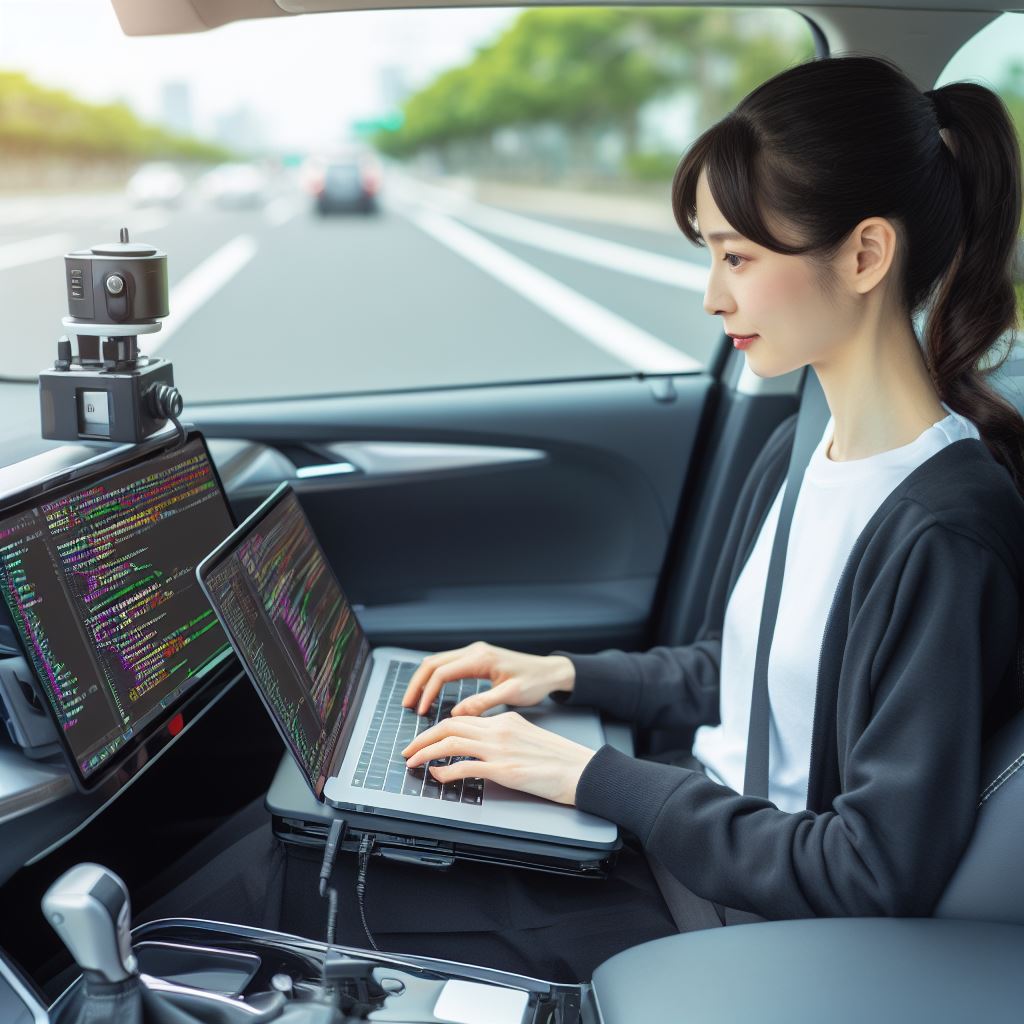Introduction
Self-driving cars: Revolutionizing the way we travel, these autonomous vehicles navigate without human intervention. This blog post explores How to Code Self Driving Cars AI Algorithms.
In today’s world, they hold immense significance by improving road safety and efficiency, reducing congestion, and enhancing mobility for all.
The purpose of this blog post is to provide an insightful overview of coding basic AI algorithms for self-driving cars.
Get ready to dive into the fascinating world of autonomous driving!
Understanding AI Algorithms in Self-Driving Cars
A. The role of AI algorithms in enabling self-driving cars to operate autonomously
AI algorithms play a critical role in enabling self-driving cars to operate autonomously.
These algorithms are responsible for processing vast amounts of data and making real-time decisions to ensure the safety and efficiency of the vehicle.
Let’s explore the different types of AI algorithms commonly used in self-driving cars:
B. Types of AI algorithms commonly used in self-driving cars
1. Perception Algorithms
Perception algorithms are used to help self-driving cars understand and interpret their surrounding environment.
These algorithms utilize various sensors, such as cameras, radar, and lidar, to gather data about objects, road conditions, and other vehicles.
By analyzing this data, perception algorithms can detect and classify objects in real-time.
For instance, perception algorithms can identify pedestrians, cyclists, traffic signals, lane markings, and other vehicles on the road.
This information is vital for the autonomous vehicle to make informed decisions and navigate its path safely.
2. Decision-making Algorithms
Decision-making algorithms in self-driving cars are responsible for analyzing data from perception algorithms and making real-time decisions based on predefined rules and models.
These algorithms consider factors like traffic laws, road conditions, and the behavior of other road users.
Decision-making algorithms take into account multiple factors and scenarios, such as lane changing, merging, speed adaptation, and overtaking.
Tech Consulting Tailored to Your Coding Journey
Get expert guidance in coding with a personalized consultation. Receive unique, actionable insights delivered in 1-3 business days.
Get StartedBy evaluating these factors, the algorithms can determine the safest and most efficient actions for the self-driving car to take in each situation.
3. Control Algorithms
Control algorithms are the ones responsible for implementing the decisions made by the decision-making algorithms.
These algorithms ensure the physical control of the vehicle, including controlling the throttle, brakes, steering, and other vehicle systems.
Control algorithms use inputs from the decision-making algorithms to adjust the vehicle’s speed, direction, and acceleration.
They continuously monitor the vehicle’s behavior and make adjustments as necessary to ensure a smooth and safe ride.
In essence, AI algorithms are vital components in enabling self-driving cars to operate autonomously.
Perception algorithms help the vehicle understand its environment, decision-making algorithms analyze data and make informed choices, and control algorithms ensure the vehicle responds appropriately.
Through the seamless integration of these algorithms, self-driving cars are becoming a reality, revolutionizing the way we travel and potentially reducing accidents caused by human errors.
Read: Automating Finances: Coding AI for Personal Budgeting
Getting Started with Coding AI Algorithms for Self-Driving Cars
When it comes to coding AI algorithms for self-driving cars, there are a few key things to keep in mind.
In this section, we will provide an overview of the programming languages commonly used for this task and discuss the importance of understanding data structures and algorithms.
Additionally, we will delve into the necessity of having a strong foundation in mathematics, particularly in linear algebra and calculus.
A. Programming Languages for Coding AI Algorithms
There are several programming languages that are commonly used for coding AI algorithms for self-driving cars.
Let’s take a look at three of the most popular ones:
Build Your Vision, Perfectly Tailored
Get a custom-built website or application that matches your vision and needs. Stand out from the crowd with a solution designed just for you—professional, scalable, and seamless.
Get Started- Python: Python is widely used due to its simplicity and readability. It has a vast array of libraries that specifically cater to AI and machine learning.
- C++: C++ is a powerful language known for its efficiency and speed. It is often used when performance is a critical requirement.
- MATLAB: MATLAB provides a high-level programming environment that is well-suited for numerical analysis and matrix operations.
B. Understanding Data Structures and Algorithms
Having a good understanding of data structures and algorithms is crucial when coding AI algorithms for self-driving cars.
Data structures allow us to organize and store data efficiently, while algorithms provide the necessary instructions for processing that data.
The choice of appropriate data structures and algorithms can greatly impact the performance of our AI models.
C. Foundation in Mathematics
Mathematics forms the backbone of AI algorithms.
Linear algebra is particularly important, as it deals with vectors and matrices, which are fundamental in representing and manipulating data.
Calculus is also essential, as many AI algorithms involve optimization and numerical analysis.
In fact, coding AI algorithms for self-driving cars requires a strong foundation in programming languages such as Python, C++, or MATLAB.
Understanding data structures and algorithms is vital for efficient and effective processing of data.
Additionally, having a solid grasp of mathematics, especially linear algebra and calculus, is essential for coding advanced AI algorithms.
By mastering these areas, one can embark on an exciting journey of developing AI algorithms for self-driving cars.
Read: Top 10 Coding Test Platforms for Hiring Top Talent

Key AI Algorithms for Self-Driving Cars
A. Perception Algorithms
Computer vision is a fundamental aspect of perception algorithms for self-driving cars.
It enables the vehicle to understand and interpret its surroundings through visual data.
By using computer vision algorithms, self-driving cars can detect objects, identify lanes, and track pedestrians.
Optimize Your Profile, Get Noticed
Make your resume and LinkedIn stand out to employers with a profile that highlights your technical skills and project experience. Elevate your career with a polished and professional presence.
Get NoticedObject detection is a popular technique in computer vision that allows self-driving cars to identify and classify different objects on the road, such as vehicles, traffic signs, and pedestrians.
This information is crucial for the car’s decision-making process.
Lane detection is another important computer vision algorithm for self-driving cars. It enables the vehicle to recognize the boundaries of lanes on the road.
By accurately detecting lanes, self-driving cars can navigate and stay within their designated driving areas.
Pedestrian tracking is a technique that allows self-driving cars to detect and track pedestrians in real-time.
This algorithm is important for ensuring the safety of pedestrians and making informed decisions while driving.
B. Decision-Making Algorithms
Machine learning algorithms play a significant role in the decision-making process of self-driving cars.
These algorithms enable the vehicle to learn from past experiences and make informed decisions based on the current situation.
Reinforcement learning is a popular algorithm used in self-driving cars. It involves training the car to make decisions based on rewards and penalties received throughout the learning process.
By continuously evaluating and adjusting its actions, the car learns to improve its driving performance.
Deep learning is another widely used algorithm in self-driving cars.
It involves training artificial neural networks to analyze and process large amounts of data, enabling the car to make intelligent decisions based on patterns and correlations in the input data.
Deep learning algorithms help self-driving cars recognize and understand complex visual scenes, enhancing their overall perception capabilities.
C. Control Algorithms
The Control theory is essential for self-driving cars to maintain control and ensure safe and efficient motion.
Control algorithms enable the car to adjust its actions and respond to various driving conditions.
One important control algorithm used in self-driving cars is the PID controller.
PID stands for Proportional, Integral, and Derivative, and it is a feedback control mechanism that continuously adjusts the car’s motion based on the difference between the desired and actual performance.
PID controllers help self-driving cars maintain stability and precise control over their speed, direction, and position.
In short, self-driving cars rely on key AI algorithms for various tasks.
Perception algorithms utilizing computer vision enable the car to understand its surroundings, while decision-making algorithms powered by machine learning and deep learning enhance its ability to make informed decisions.
Control algorithms, such as PID controllers, ensure precise motion control for safe and efficient driving.
These algorithms pave the way for the future of autonomous vehicles, revolutionizing the way we travel.
Read: AI in Cybersecurity: Coding for Threat Detection
Challenges and Considerations in Coding AI Algorithms for Self-Driving Cars
A. Challenges and complexities involved in designing and implementing AI algorithms for self-driving cars
One of the biggest challenges in coding AI algorithms for self-driving cars is ensuring safety.
Self-driving cars must be able to handle uncertainty and unexpected scenarios on the road.
Designing algorithms that can make real-time decisions and perform in a timely manner is crucial.
Extensive testing and validation are essential to ensure the reliability and safety of these algorithms.
Safety considerations are of the utmost importance when coding AI algorithms for self-driving cars.
The algorithms need to be able to handle various scenarios and prioritize the safety of passengers and pedestrians.
Uncertainty is a major challenge, as self-driving cars must be able to react to unexpected situations on the road.
The algorithms need to be able to adapt and make decisions based on incomplete or conflicting information.
Real-time performance requirements add another layer of complexity to coding AI algorithms for self-driving cars.
B. Importance of extensive testing and validation to ensure the algorithms’ reliability and safety
The algorithms need to process vast amounts of data quickly and make decisions in a timely manner.
Testing and validation are vital to ensure the algorithms’ reliability and safety on the road.
Extensive testing in various scenarios is necessary to identify and address any potential flaws or vulnerabilities.
Read: Mastering SOAP APIs: Tips for Java Developers
Conclusion
Coding basic AI algorithms for self-driving cars is crucial for their success.
These algorithms enable the cars to make intelligent decisions and navigate safely.
By understanding how to code these algorithms, developers can contribute to the advancement of self-driving car technologies.
It is important to note that coding AI algorithms is a continuous learning process.
Developers should explore further resources, such as books, online courses, and forums.
Continued learning will help them stay updated with the latest advancements in self-driving car technologies.
By expanding their knowledge, developers can contribute to the development of safer and more efficient self-driving cars.
As technology progresses, more opportunities for innovation in the field of self-driving cars will arise.
Therefore, it is crucial to stay curious, explore new ideas, and push the boundaries of self-driving car technologies through coding AI algorithms.




